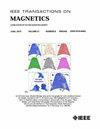Magnetic Relaxation of Gd-Doped MnFe2O4 Nanoparticles for MR Effect and Heat Dissipation
IF 1.9
3区 工程技术
Q3 ENGINEERING, ELECTRICAL & ELECTRONIC
引用次数: 0
Abstract
MnGdxFe2-xO4 nanoparticles (gd掺杂MnFe2O4纳米粒子磁弛豫的磁流变效应和散热
在无定形SiO2中掺杂少量Gd离子制备了MnGdxFe2-xO4纳米粒子(${x} =0$, 0.05, 0.10),并对其磁弛豫和磁共振(MR)效应进行了研究。采用金属氯化物与偏硅酸钠溶液湿法混合制备样品,通过调节退火温度将样品粒度控制在18 nm。采用自旋回波法对${T} _{1}$和${T} _{2}$进行弛豫测量,并对磁共振信号进行测量。所有样品均表现出${T} _{2}$松弛的缩短效应。这些现象可归因于Gd磁矩的强烈影响,它在$4{f}$轨道上对质子有最多7个未配对电子。在${T} _{1}$信号处也观察到显性缩短效应。同样的样品被检查,看看它是否可以作为热疗的试剂。研究人员在交流磁场中升高温度,并用人类乳腺癌细胞进行了体外实验。因此,观察到优越的热疗效果,这些样品有望在未来成为具有治疗功能的药物。
本文章由计算机程序翻译,如有差异,请以英文原文为准。
求助全文
约1分钟内获得全文
求助全文
来源期刊

IEEE Transactions on Magnetics
工程技术-工程:电子与电气
CiteScore
4.00
自引率
14.30%
发文量
565
审稿时长
4.1 months
期刊介绍:
Science and technology related to the basic physics and engineering of magnetism, magnetic materials, applied magnetics, magnetic devices, and magnetic data storage. The IEEE Transactions on Magnetics publishes scholarly articles of archival value as well as tutorial expositions and critical reviews of classical subjects and topics of current interest.
 求助内容:
求助内容: 应助结果提醒方式:
应助结果提醒方式:


